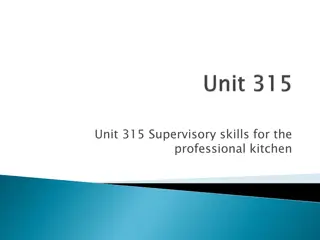Supplier Onsite Assessments for Food Safety Compliance
Conducting onsite assessments at food suppliers producing ice cream products, RTE nuts, and RTE spinach dairy dip reveals critical findings related to process control, equipment maintenance, environmental monitoring, and microbial hazards. The assessments highlight gaps in HACCP design/validation, e
2 views • 8 slides
Overview of Food and Beverage Management at President Hotel, Athens
Food and Beverage Management at President Hotel in Athens involves various roles such as F&B Manager, Assistant Manager, Chef, and service staff. The department oversees bars, banquet services, room service, and more. The main duties include HACCP compliance, menu planning, cooperation with other de
0 views • 15 slides
Introduction to SFBB: A Safer Food Management System
Discover how Safer Food, Better Business (SFBB) can help food businesses comply with legal requirements, implement safe methods, and maintain food safety management procedures based on HACCP principles. Learn about the benefits of introducing SFBB, its easy-to-understand and flexible nature, and how
3 views • 15 slides
Understanding HARPC and Its Food Safety Implications
The implementation of HARPC (Hazard Analysis and Risk-Based Preventive Controls) under the Food Safety Modernization Act (FSMA) represents a significant shift towards preventive measures in ensuring food safety. This reform impacts various stakeholders in the food industry, emphasizing the identific
0 views • 17 slides
Understanding Food Safety Legislation and Supervisory Roles in the Hospitality Industry
Explore the crucial role of supervisors in upholding food safety legislation in hospitality settings. Learn about the principles, processes, and responsibilities related to food safety and health regulations. Understand the significance of HACCP, government involvement in food safety, and employer a
0 views • 51 slides
Importance of Meat Hygiene and Sanitation in the Meat Industry
Meat hygiene is essential to ensure the safety and suitability of meat for consumers. It involves implementing specific standards and regulatory actions to maintain cleanliness and prevent contamination at all stages of production. Proper cleaning and sanitization practices, adherence to legal stand
0 views • 16 slides
Food Safety and Quality Management in the Food Industry
Food safety is a critical concern in the food industry due to frequent outbreaks and consumer uncertainty. To meet market needs and legal requirements, producers must adhere to specific standards and implement systems for managing quality and safety. Quality assurance systems like GAPs, GMPs, and HA
2 views • 12 slides
Ensuring the Safety and Quality of Food through HACCP Principles
Food quality and safety are crucial for consumer well-being. Effective programs such as HACCP help identify, evaluate, and control food safety hazards. This systematic approach focuses on prevention rather than reaction, ensuring the production of wholesome and nutritious food. Learn about the key p
0 views • 33 slides
Mastering Good Food Hygiene and Storage Practices
Understanding food spoilage causes, common food-poisoning bacteria, conditions for bacterial growth, ways to prevent food contamination, safe food handling practices, HACCP concept, types of perishable foods, importance of proper food storage, packaging materials for food, and recognizing signs of f
1 views • 27 slides
Ensuring Food Safety in Hawaii Child Nutrition Programs
Food safety practices and guidelines are essential in Hawaii Child Nutrition Programs to prevent diseases like Rat Lungworm. Measures include thorough inspection and rinsing of produce, compliance with regulations for washing produce, and following protocols such as HACCP principles. Regular monitor
0 views • 25 slides
SQF Code Certification Levels and Requirements Guide
SQF Code offers three certification levels: Level 1 focuses on Food Safety Fundamentals, Level 2 incorporates HACCP Food Safety Plans, and Level 3 integrates Quality Management Systems. The certification process involves selecting modules, registering in the assessment database, designating a practi
0 views • 10 slides
Food Protection Programs Implementation Guidelines
This document outlines the requirements and procedures for food protection programs installation as per regulations specified in DA Pam 30-22. It covers aspects such as food risk management, training, integrated pest management, and the Army Composite Risk Management process. Emphasis is placed on m
0 views • 15 slides
Understanding HACCP Terminology and Necessity
Hazard Analysis and Critical Control Points (HACCP) play a crucial role in ensuring food safety. This article emphasizes the necessity of HACCP, outlines key terminology such as hazards, contamination, control measures, critical control points, and provides insights into HACCP plan, risk assessment,
0 views • 18 slides
Providing Meals in Early Education Centers: LAUSD Food Services Division Training
Learn about the Early Education Process (EEC) and USDA regulations for meal provision in Early Education Centers. Topics covered include mandatory postings, meal service requirements, staff responsibilities, and HACCP procedures for food safety. Training provided by the LAUSD Food Services Division.
0 views • 79 slides
Evolution of HACCP in Microbial Food Safety: A Comprehensive Overview
Explore the evolution of Hazard Analysis and Critical Control Points (HACCP) in ensuring microbial food safety, from its development in the 1960s for astronaut food to its mandatory regulations in the food industry. Discover key principles, challenges, and control measures associated with PR/HACCP i
0 views • 19 slides














